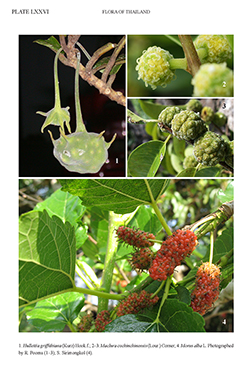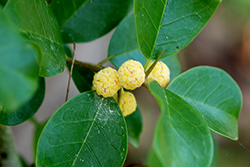e-Flora of Thailand
Volume 10 > Part 4 > Year 2011 > Page 655 > Moraceae > Maclura
2. Maclura cochinchinensis (Lour.) Cornerwfo-0000448071
Gard. Bull. Singapore 19: 239. 1962; C.C.Berg et al., Fl. Males., Ser. 1, Spermat. 17(2): 36. 2005.— Vanieria cochinchinensis Lour., Fl. Cochinch. 564. 1790.— Procris cochinchinensis (Lour.) Spreng., Syst. Veg. 3: 846. 1816.— Cudrania cochinchinensis (Lour.) Kudo & Masam., Ann. Rep. Taihoku Bot. Gard. 2: 27. 1932. Plate LXXVI: 2–3.
Accepted Name : This is currently accepted.
Synonyms & Citations :
Description : Shrub, much-branched with long scrambling sprays, or climber, with curved or straight thorns to 4 cm long. Leafy twigs 1.5–4 mm thick, densely brownish to whitish puberulous, subtomentose or subglabrous, drying brown to greyish, often with conspicuous lenticels. Leaves spirally arranged to distichous; lamina oblong, subobovate or elliptic, (0.5–)4–14 by (0.3–)1.5–5 cm, subcoriaceous to chartaceous, apex acuminate, subacute or rounded, base obtuse to rounded or cuneate, margin entire; upper surface glabrous, lower surface sparsely densely brown to whitish puberulous to subtomentose on all veins, or mainly on the midrib or glabrous; midrib impressed above, lateral veins (4–)6–9(–14) pairs, the lower ones faintly to clearly loop connected, tertiary venation reticulate to subscalariform; petiole (0.3–)0.8–1.5(–2) cm long, densely brown to whitish to subtomentose to glabrous; stipules 0.2–0.4 cm long, (sparsely) puberulous, caducous (or subpersistent). Staminate inflorescences axillary, solitary or in pairs; peduncle 0.3–1 cm long, puberulous; head 0.3–1 cm diam.; tepals 1–1.5 mm long, ciliolate or puberulous to tomentellous; stamens ca 1 mm long, anthers 0.4–0.5 mm long; bracts basally attached, 0.5–1 mm long, minutely puberulous. Pistillate inflorescences axillary, in pairs or solitary; peduncle 0.4–1.2 cm long, puberulous; head 0.4–0.8 cm diam.; flowers basally connate; perianth ca 1 mm long, sparsely to densely white puberulous to tomentellous, ovary ca 1 mm long, style 0.5 mm long, stigmas 2–3 mm long, twisted; bracts basally attached, 0.5–1 mm long, sparsely to densely puberulous. Infructescences globose, 1–2 cm diam., yellow or orange to red at maturity.
Thailand : Throughout the country.
Distribution : Sri Lanka, India, Bhutan, Sikkim, China Japan, Taiwan, Burma, Laos, Vietnam, Cambodia, Peninsular and Bornean Malaysia, Indonesia (throughout), the Philippines, Papua New Guinea, Australia, New Caledonia.
Ecology : Dry evergreen, mixed deciduous and montane forests, to 2,000 m alt.
Vernacular : Kamlang wua thalueng (กำลังวัวเถลิง)(Chumphon); kae lae (แกแล)(Chon Buri); kho sam pao (โค้ะส้มเปา)(Mae Hong Son).
Uses: The infructescences are edible and the wood is used for dyeing silk yellow, red or green.
Notes: The species as currently defined is quite variable, for example, in the presence and colour of the indumentum on various parts (such as the lower surface of the lamina) and in the shape, in particular the apex of the lamina, varying from acuminate to rounded. In laminas with acuminate apices the tertiary venation tends to subscalariform. The thorns vary from curved (and relatively short) to straight (and relatively long).


